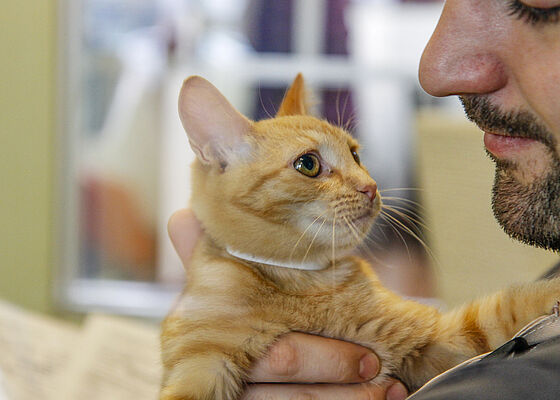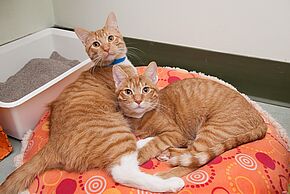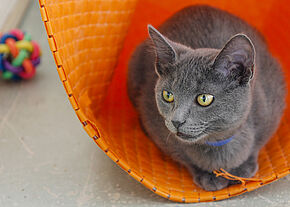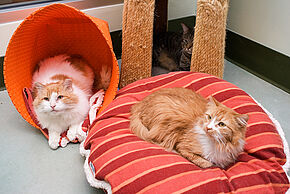Litter Box Problems
If your cat is having trouble using the litter box, contact your vet immediately. It could be a medical issue. House soiling is never done to spite the owner. Never punish your cat for eliminating outside of his litter box. Instead, try to understand the cause of the problem. If it isn't a health issue, it may be the result of an undesirable litter box or a stressful environment. Remember, if you have multiple cats, the number of litter boxes you will need is equal to the number of cats you have, plus one.
- Health Concerns: Avoiding or not using the litter box is often the first sign of a urinary tract disorder. It is likely the discomfort associated with eliminating may lead to aversion. Urinary tract issues that cause blockages can be life-threatening. This is an emergency situation. Diarrhea, constipation, parasites, foreign body ingestion and colitis are other problems that can result in discomfort and cause litter box avoidance. See your vet immediately.
- Undesirable Litter Box: If your car starts defecating outside the box, there may be something about the box he finds undesirable. The accumulation of waste, odor, unacceptable litter or a bad experience may be the issue. Consider a gradual switch to something different to see if that helps. And remember to always keep the litter box clean. Your cat’s box should be scooped at least once a day (extra fastidious cats may require two cleanings per day). Each box should be completely dumped and thoroughly cleaned with water and a mild detergent every two weeks.
- Environmental Stress: When a cat is urinating on a specific object, such as your clothing, bed, favorite chair or shoes, it may be an anxiety problem. If there are emotional factors in play, you may see other behavioral changes, such as avoidance, hiding, aggression or a general change in the pet’s behavior. In these cases, you may need to do a bit of detective work. Another cat in the house could be guarding the box or boxes. Make sure you have one litter box for each cat, plus one additional box. Place them in multiple locations throughout the home. Or the box might be located in area with too much human traffic or noise. In this case, you should move the box to a quieter area.
Spraying
Spraying is when a cat urinates in his or her environment. It is a territorial response to a change in the home’s scent structure. Cats will revisit and re-mark an area to freshen up a fading scent.
Conditions that may cause spraying include:
- Another cat visiting in the yard
- New pet or family member
- Problem with a member of the household
- Problem with another pet
- Moving or remodeling
- Visitors
Spaying or neutering is effective in reducing this behavior in 90% of males and 95% of females.
Once spraying has occurred, it is important to thoroughly clean the area and neutralize the urine odor. If a cat can smell the urine, he or she will continue to eliminate in that area.
Follow these steps to start:
- If the area is still wet, soak up as much as possible with cloth or paper towels.
- Use an enzymatic cleaner, which will break down the proteins in urine that cause odor. You should be able to find these at any pet store. Be sure to follow the manufacturer’s instructions.
- If any odors persist, apply a solution of one part vinegar to one part water to the area. Vinegar should neutralize the smell. Be sure to thoroughly dry the area.
Please note that under some circumstances, it might be impossible to completely remove the urine smell. For example, if the urine seeps through carpet into the underlying padding, the odor may persist. In these cases, it may be necessary to replace the carpeting and padding.
Inappropriate Playing
Playful attacks, such as nipping, are not accompanied by vocalization, hissing or growling. A natural reaction to being grabbed or bitten, even playfully, is to swat at the cat. Do not do this. Physical punishment may cause your cat either to fear you or engage in even rougher play.
Instead, follow these steps:
- Use your voice. A loud and shrill “Eek!” followed by a sharp “No!” can be very effective with some cats.
- Shun the cat for the next 10 minutes. This means paying absolutely no attention to the cat. Don’t lecture, scold or pick the cat up and move him to a different room. Any attention at this point can be considered reinforcing.
This is how a kitten learns to inhibit biting when playing with another kitten. If one becomes too rough, the victim will squeal and run away. The aggressor will watch his playmate run away and wonder what happened. Eventually he learns that if he wants to extend his play session, he has to play in a more gentle way.
Often, inappropriate play is caused by a lack of structured, interactive play between the cat and his human. Read more about appropriate play here.
Mouthing
A cat who “mouths” or bites for attention may have been raised without siblings or a mother to teach him appropriate play. A human may have taught her that hands are, indeed, toys, or she may be frustrated due to a lack of play and enrichment.
Ignoring the cat and withholding attention for 10 minutes or so after behaving inappropriately is a safe and humane method of punishment. By repeatedly taking away the attention the cat craves, he will eventually learn that certain behaviors elicit positive rewards while other elicit nothing pleasurable.
While the cat is learning which behaviors are acceptable and which are not, it is important to keep safety in mind. Play with toys that increase the distance between the human caregiver and the cat, such as laser pointers or wand toys. Remember the importance of play. Consistent play exhausts the cat’s energy reserve and also lessens any frustration he may feel due to boredom. When a cat’s play needs are sufficiently met, he loses interest in his human caregiver’s ankles or hands as a source of prey.
Aggression
Territorial Aggression
Social aggression between cats sharing a house develops gradually. It starts with hissing and growling, progresses to swatting and chasing, and finally involves attacking and fighting. These disputes generally arise when either cat reaches maturity (8 to 24 months).
If this happens, the victimized cat will usually retreat to a remote part of the house where he feels safe. He may not eat or drink when the other cat is around and ,may stop using the litter box.
The best way to restore harmony is to systematically desensitize the aggressor to the victim. It is the same process you use to introduce a new cat into the household. During reintroduction, be sure to separate them if there are any signs of aggression. Do not shout or scold: It will frighten the victim as well.
Fearful or Defensive Aggression
Fearful or defensive aggression occurs when a cat perceives itself to be under threat from which it cannot escape.
A cat may exhibit the following body postures:
- Crouching with its ears flattened against its head
- Hissing and spitting
- Hair standing up
These are all signals that further approach is likely to lead to a defensive attack. A person or animal who ignores these warning signals is likely to get hurt. It is very important to educate children and strangers on these signals.
The best way to handle a defensively aggressive cat is to avoid him until he calms down. You should not try to comfort your cat by approaching it or picking it up. He should be left alone until he relaxes enough to play, or eat, or shows signs of affection.
Redirected Aggression
Redirected aggression toward humans generally occurs when a cat is in a highly aroused, aggressive state and attacks a person within reach. This state can be caused by a loud disturbing noise, the sight of an unknown cat or having been in a fight.
Cats generally do not redirect aggression unless they are touched or closely approached by a person. The owner should wait until the cat has changed his mood before interacting with it. This state can last two hours or more, but in most cases, it is over in 30 minutes.
After the cat has engaged in another behavior, such as grooming, playing or eating, it is usually safe to approach it. To treat this type of aggression, the arousing stimulus must be identified so it can be eliminated.
Night Waking
Cats in the wild are mostly nocturnal. Domestication has shifted the cat’s activity to be more awake during the day, but they still tend to wake at least twice during the night.
To avoid night waking:
- Schedule play sessions before you go to bed. Try to play until the cat is tired.
- Feed your cat his main meal right before your bedtime. Cats tend to sleep after a big meal.
- Incorporate a variety of enrichment activities to keep your cat active during the day so he is tired at night.
- Consider adopting a playmate for your cat.
Avoid getting up and attending to your cat if he is making noise playing in the night unless you feel something is wrong. If you rise and feed or play with the cat, you are reinforcing his behavior
Plant Eating and Digging
For a cat, a potted plant is a snack, an entertainment center and a bathroom all in one. Rubbing moistened black pepper onto the leaves and placing stones on top of the dirt will dissuade your cat from tasting or digging in the plant. Before bringing a plant or flower into your home, be sure it is not poisonous to your cat. Refer to the Common Dangerous/Poisonous Household Items list.




